The battleship had emerged from the First World War with two separate batteries of medium-caliber gun, one for shooting at surface targets, and one for air targets. Some nations embraced this, but elsewhere the obvious inefficiency of having to carry two separate sets of guns of approximately the same size prompted a search for a gun, and a mounting, which could fulfill both roles. Both destroyers and aircraft were getting larger, tougher and faster, and countering them required a gun with reasonably high muzzle velocity, a large shell, and a high rate of fire. The US and Britain both installed these weapons on their treaty battleships, and refitted their older battleships with similar batteries where possible.
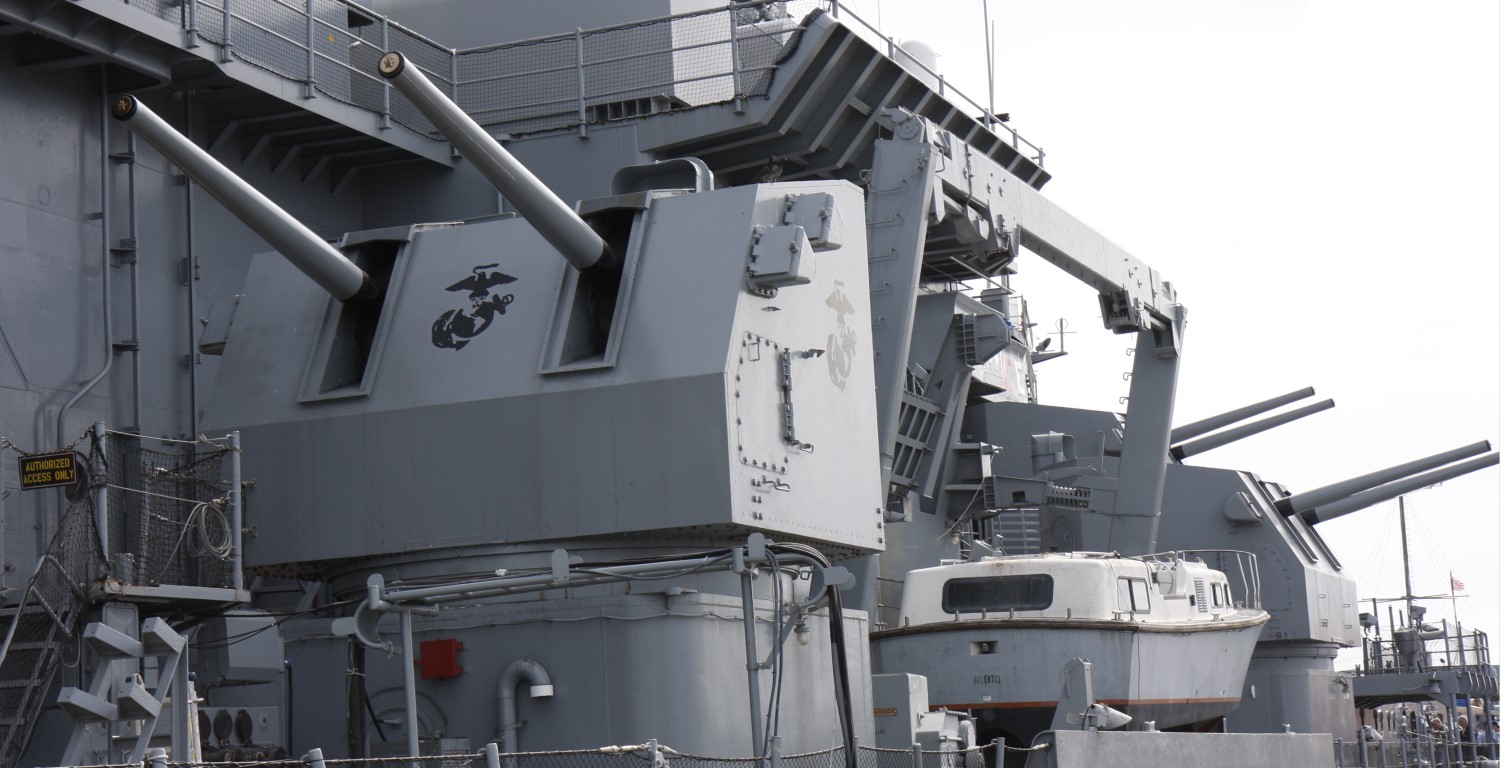
Iowa's starboard DP mounts1
Another major driver of DP guns was improved AA fire control. The first generation of AA guns had relied on barrage fire, attempting to saturate a patch of sky the target airplane would fly through. During the interwar period, however, systems like the British High-Angle Control System and the American Mk 37 director2 were developed which would theoretically allow accurate engagement of aerial targets. However, this method required high muzzle velocity, as the target could maneuver in the dead time between aiming and the shell reaching the target. This fit well with the need for higher muzzle velocity to reduce the dead space for anti-destroyer fire.
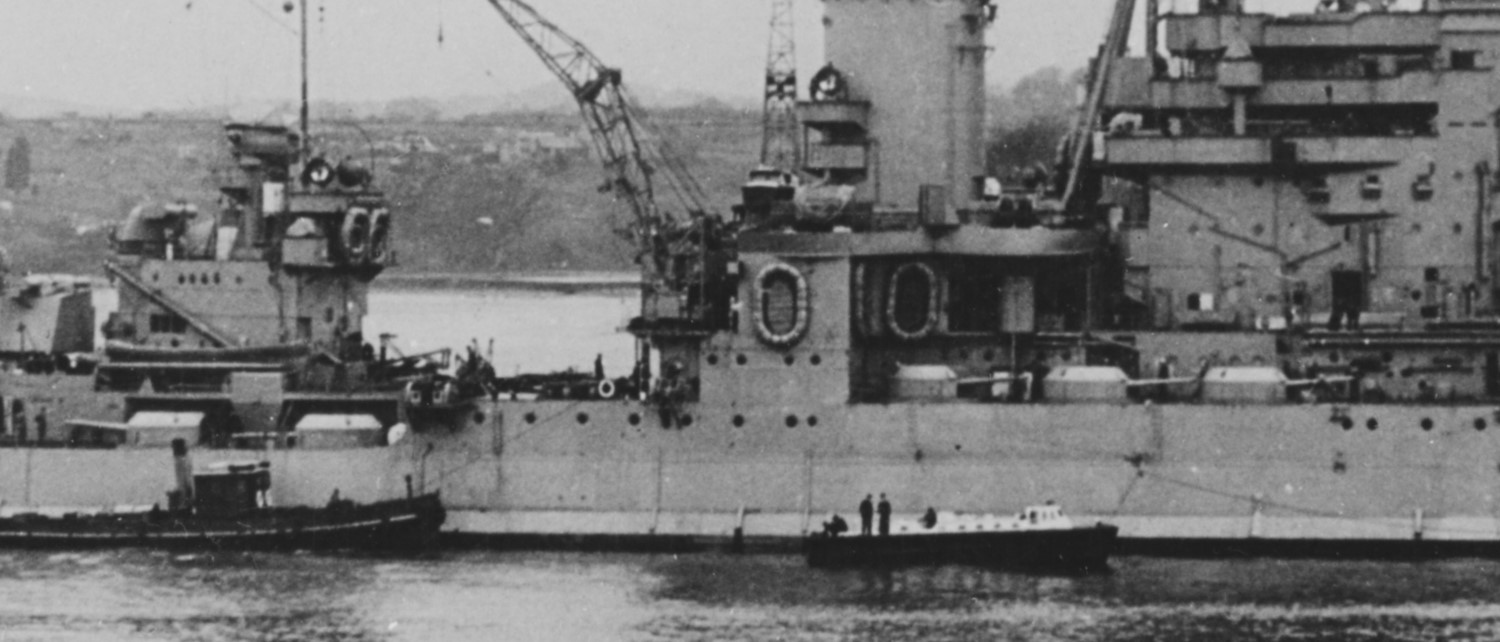
4.5" secondary battery on HMS Valiant
The British, after a complicated process that saw them investigating 4", 4.7", 5.1" and 5.5" DP guns,3 selected a 4.5"/45 gun for their reconstructed capital ships. This weapon used a so-called "Between-decks" (BD) mounting, which penetrated below the deck the gun was on, instead of simply sitting on the deck like previous mounts had done. This gun was a reasonably powerful and effective weapon, but fired a fixed round that weighed 87 lbs, of which 55 lbs was the shell. As the 74 lb round of the 4.7" AA gun on the Nelsons had been found to tire the crew easily, this decision is hard to explain, and it limited the rate of fire to no more than 12 rpm.

Secondary 5.25" turret on HMS King George V
However, the power of the 4.5" gun against surface targets was considered suspect, and another weapon was sought for a new class of dual-purpose cruisers. The resulting 5.25"/50 was loaded separately, and the 80-lb shell was considered the largest that could be manually loaded. Unfortunately, the British had made the same mistake as on the 4.5", which when combined with the cramped mountings limited the practical rate of fire to no more than 7-8 rpm. The weight of the mounts limited the King George Vs to only eight twins, and the mounts themselves were unreliable. Worse, the power training and elevation gear was not fast enough to keep up with high-speed targets. Power operation was critical to these mounts, as they were much too heavy to handle manually in action.4 This meant that emergency power for the secondary battery was now vital, and deficiencies in this area were revealed during the last battle of Prince of Wales.
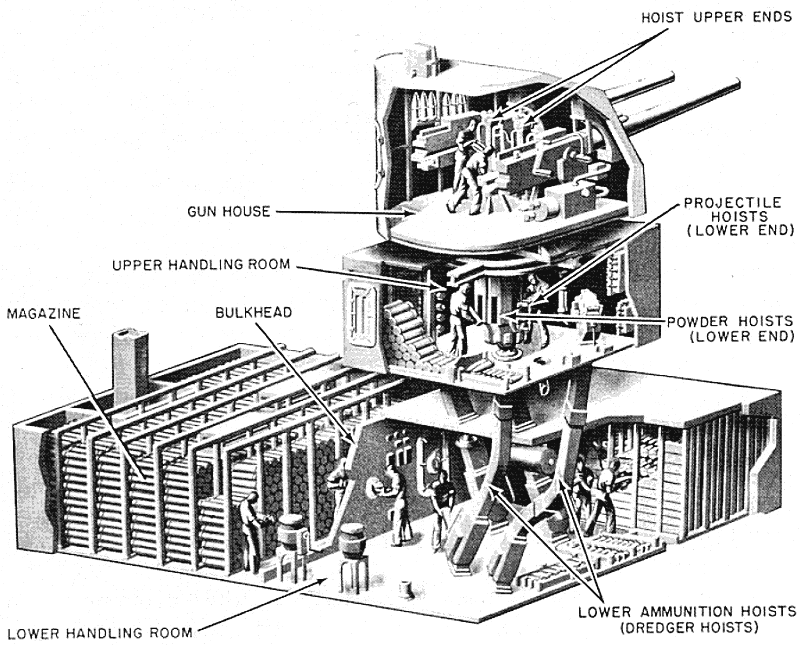
General arrangements of the twin 5"/38
In contrast to the struggles of the British, the Americans managed to solve the DP gun problem brilliantly, with the famous 5"/38, one of the greatest naval guns ever. In various single and twin mounts, it was fitted to everything from battleships to destroyers to merchant ships to aircraft carriers. First introduced into service in 1934 aboard the Farragut class destroyers, the 5"/38 was everything a weapon should be.5 Reliable, accurate, and powerful, it gave good service against surface and air targets, shooting down 30% of Japanese aircraft killed by AA fire during the war.6 The last guns were not retired from sea service with the Mexican Navy until 2014.
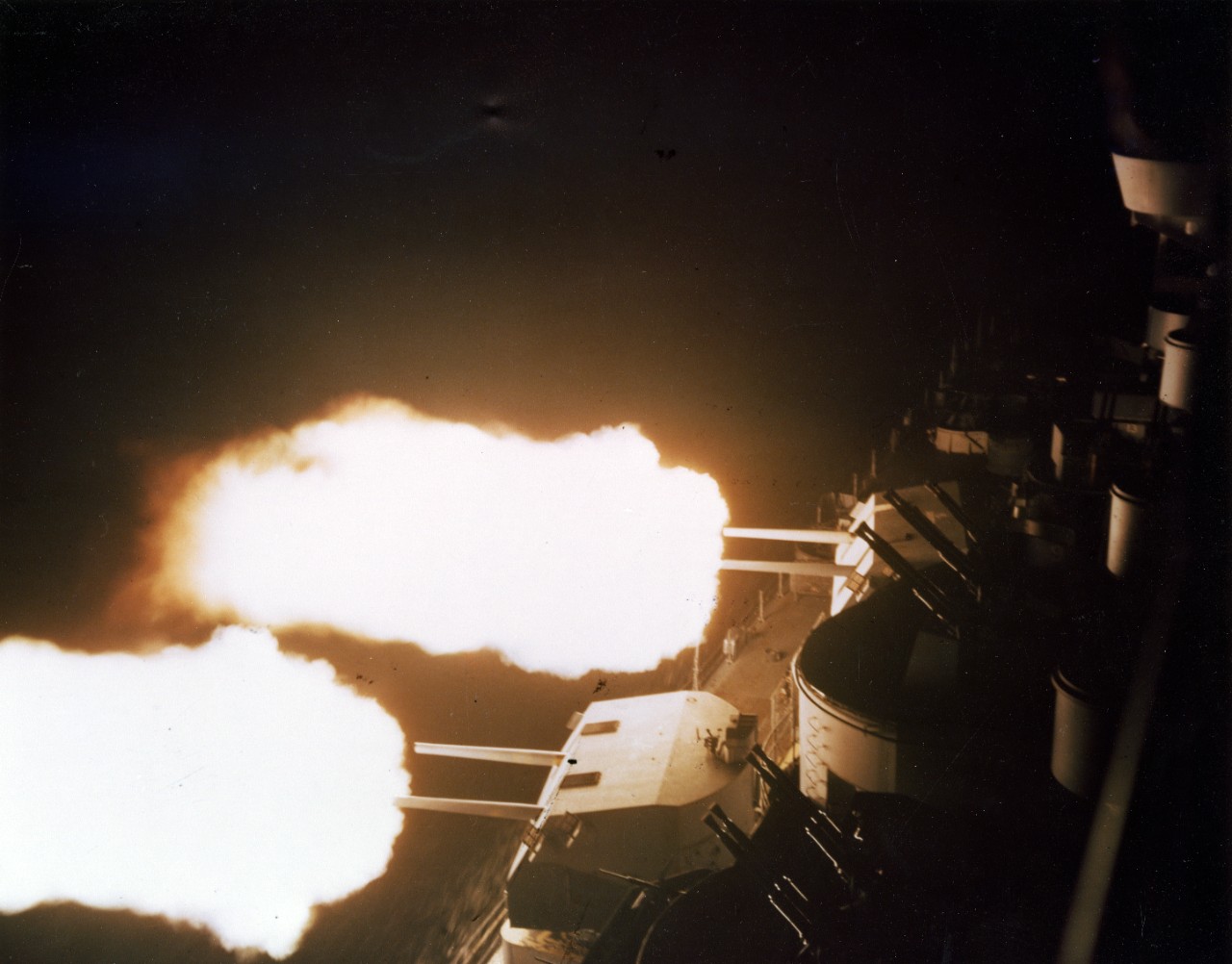
Missouri fires her 5" battery on her shakedown cruise
The Americans had done a good job evaluating the limits of loading, and the gun was separately loaded with a 55 lb shell and a brass cartridge which weighed about 30 lb when full of powder. Power ramming and well-placed trunions meant that the standard rate of fire of 15 rpm per gun could be maintained even at high angles, and a good crew could reach 22 rpm for a short time.7 Another key factor in reaching this rate of fire was the mount design. Traditionally, AA guns had been supplied with ammunition from a fixed position on the deck, which then went into the fuze-setter near the gun, and from there into the breech. This path could become tangled at high elevation or at extreme train angles, and on almost all 5"/38s, ammunition was instead supplied through a set of hoists at the center of the mount. These hoists meant that the ammunition was always supplied to the crew in a convenient position, and the integrated fuze-setters removed a step that had previously slowed the rate of fire significantly.8
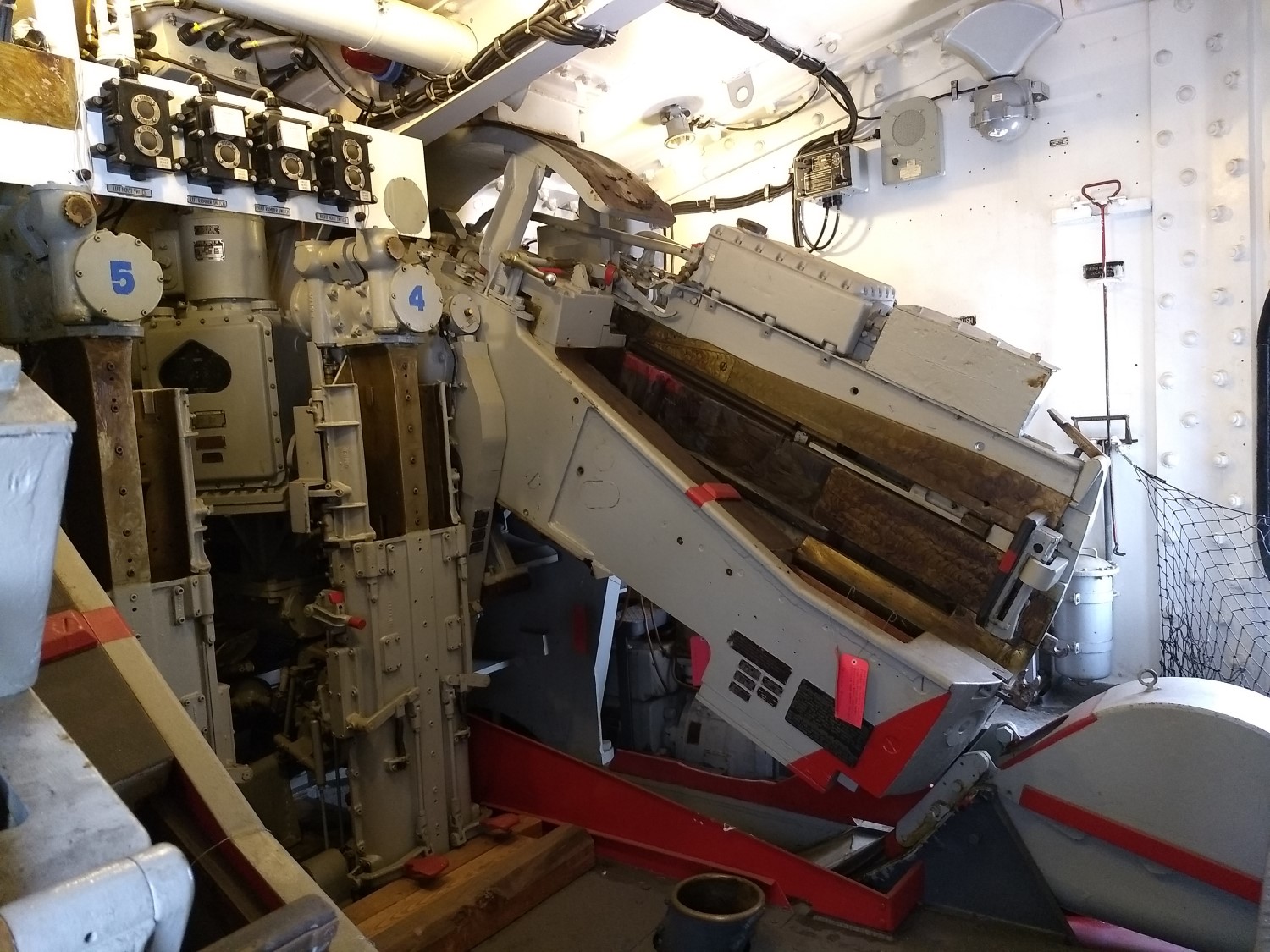
Inside one of the 5" gunhouses on Iowa. Note hoists on the left, labeled 4 and 5.9
With a muzzle velocity of 2,600 ft/sec, the 5"/38 could hurl a projectile to a range of about 18,000 yds, and as high as 37,000 ft. In theory this makes Iowa a threat to airliners at cruising altitude, although in practice, range at that altitude was essentially zero. Several varieties of shell were available. The most widely used was AA Common, a high explosive fragment shell initially fitted with time fuzes and later with proximity fuzes which were essentially a tiny radar that would set the shell off when it got close enough to a plane. These shells could also be fitted with contact fuzes for use against surface targets. Regular common shells also were used, with less explosive and more armor penetration. Other varieties of shell included white phosphorus for smoke generation and setting things on fire,10 star shells for night combat, and "window" or chaff for creating false radar targets. Iowa was completed with ten twin 5" mounts, five on each side of the superstructure. In the 80s, four of these mounts were removed to provide space and weight for the new missiles.
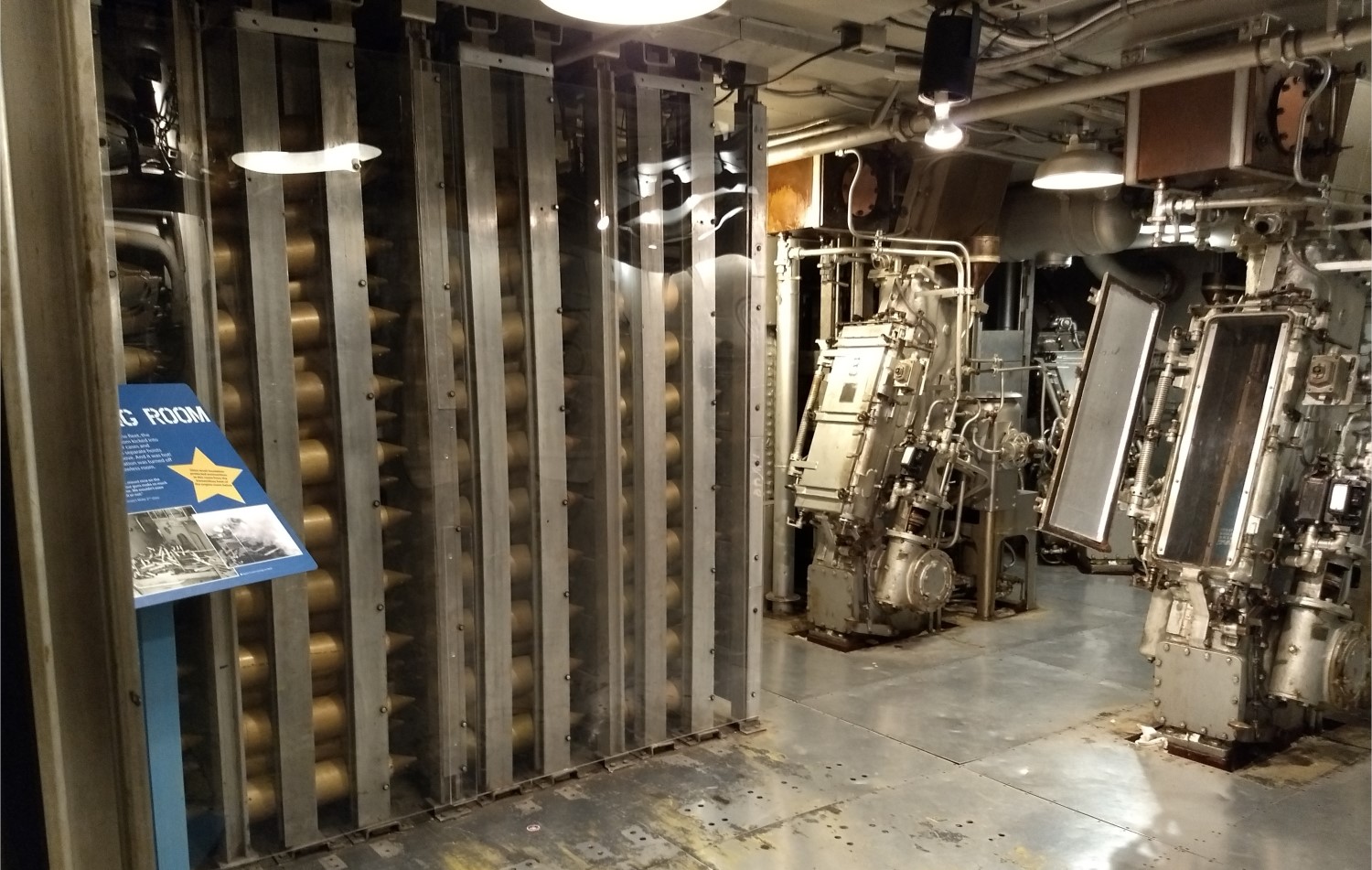
5" magazine on Massachusetts
The shells and charges are stored in magazines deep in the ship. When it's time to use them, they are passed up through chain hoists into the handling room. This room, directly under the mount, serves to pass the shells from the magazines into the hoists to the mount, and the powder into the scuttles leading up through the floor. This allowed the mounting designers to avoid the problems of a mechanical coupling between the rotating mount and the fixed paths up from the magazine. 5 men manned the upper handling room, while 8 occupied the magazines.

Plan view of a 5" twin mount
A total of 14 men occupied the gunhouse proper, which a lot of visitors find hard to believe when they're looking inside. The mount captain controlled the entire mount, while each gun had its own captain responsible for maintaining it and fixing it if anything went wrong. The pointer and trainer were to take over if the remote control failed, either matching the pointers or keeping their sights on the target. The sights were set by the sight setter, who sits between the guns. Next to him was the fuze setter, responsible for setting the time fuzes if the automatic control was offline for some reason. A checker made sure that the sights are on target. The primary responsibility for loading each gun fell to three men: the projectile-man, powder-man, and hot case man. The first two were responsible for placing the shell and charge onto the loading tray and ramming them, while the last-named made sure that the hot casings ejected were not left to rattle around inside the gunhouse, burning the crew.
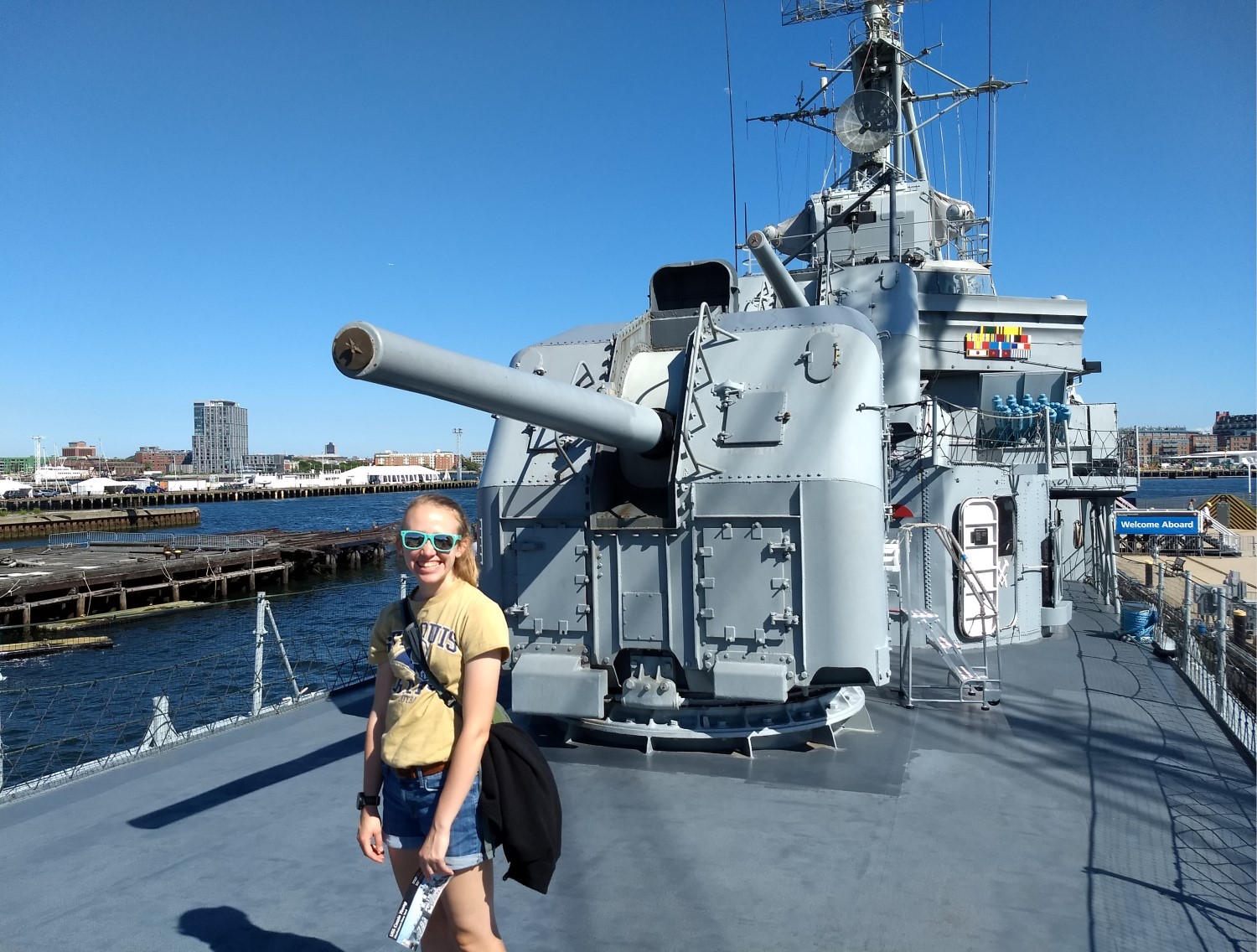
Sister Bean with two single 5" mounts on Cassin Young
The 5"/38 was probably the finest gun of its type ever built, and gave the American battleship unmatched capability against air, surface and land targets. But it itself was not enough when faced with the air threats of the day. Lighter, faster-tracking weapons were required, and we'll take a look at them next time.
1 Note the Eagle, Globe, and Anchor on Mount 56. One of the secondary mounts was traditionally manned by the Marine detachment, and was marked as such. Photo courtesy of The Fatherly One. ⇑
2 I intend to examine both of these systems in some detail. They worked on rather different principles, and their relative merits can be evaluated by the British adoption of the Mk 37 aboard Vanguard. ⇑
3 A twin 4" was widely used, but not on their battleships. ⇑
4 On my first day as a tour guide, I got to elevate the guns of Mount 55 by hand, but it was for their use in a salute to the San Pedro Boat Parade that evening, and they didn't elevate very fast. ⇑
5 It's worth pointing out that it didn't spring from BuOrd fully formed and perfect. There were initial teething troubles, but they were sorted out before WWII. ⇑
6 This was split evenly between guns firing time-fuzed and proximity-fuzed ammunition, although only half as many rounds of the later were fired. ⇑
7 This was not commonly done, as the fuzes were set based on an assumed dead time between leaving the hoist and being fired. Shooting early or late could throw them off, reducing the chance of a kill significantly. Proximity fuzes solved this problem when they were introduced in 1943. ⇑
8 The British only fitted hoist fuze-setters to a few of their guns, which usually fired about 25% faster than the same guns with separate fuze-setting gear. ⇑
9 This picture, and all but the diagram in the rest of the post, are mine. ⇑
10 The US military has only ever used WP for marking targets. That's their story, and they're sticking to it. ⇑

Comments
Now I see the inspiration for the anti-fighter mounts on the Death Star in Star Wars! I'm surprised they were that blatant about making the futuristic lasers look and work just like the real explosive weapons.
On a more relevant subject: note 6 suggests that the fuses were on a strict timer, that started when the shell left the hoist. I had previously thought that fuses were timed from the instant of firing, either by the temperature or acceleration of firing itself. That seems both more accurate and safer than a timer with an assumed dead time. More accurate since you're only paying attention to time since leaving the gun, and safer because, well, the obvious. Would hate to have an issue with your gun that led to your own rounds blowing up inside the gunhouse because you couldn't fire them in time! Why was this done this way?
The timer was indeed started when the gun fired, and set based on the time of flight. But ToF is constantly changing, and the computer had to take the time from when the shell left the hoist into account when setting it.
Oh, I see - the assumption was in where the target plane would be by the time the shell was fired, not the whole chain of everything. Much more rational than my initial interpretation. I'm surprised that made enough of a difference in accuracy to outweigh 50% extra shots!
It usually wasn't a cost of 50%. 22 rpm is a good crew firing a short burst, and couldn't have been sustained. I suspect that the dead time was configurable, and it could have been set for 22 rpm if that was the maximum sustainable rate of fire. Actually, the biggest problem would be variable RoF. If they're consistently fast, the spotter in the director would just dial in a correction, because the shells would be bursting short. If they don't have a consistent rhythm, spotting isn't going to help much and you'll end up chasing targets all over the sky.
It's interesting to note that everything old is new again, with electronic time fuzes having made a reappearance. Of course, the clever new hack is to measure the muzzle velocity of each round and set the fuze electronically after the shell has been fired.
After the shell has been fired? Haven't heard of that. If you can do that (sources, please, mostly because I want the juicy details) then it makes sense because it's less vulnerable to countermeasures.
Oerlikon 35mm GDM-008 "Millenium Gun", see e.g. http://www.navweaps.com/Weapons/WNGER35mm-1000Millennium.php
They've (re)invented a true shrapnel round for antiair/antimissile use, and as Jade notes they inductively set the fuse just after the shell leaves the barrel, using the measured rather than predicted muzzle velocity.
Very interesting. It doesn't seem to be wildly popular, which probably means there's some hidden drawback (besides expensive ammo, that is) which is why it hasn't seen more adoption. Friedman doesn't have any more details, except that the shrapnel is actually 157 spin-stabilized penetrators, not just a regular burst.
Am I missing something, or do both the powder and projectile hoists in the handling room rotate with the turret? Did they have to drop 55lb shells into moving hoist tubes?
Also, were the secondaries a weak point in battleship armor? They weren't as well armoured as the main guns, and a hit that penetrated through the turret ring to that magazine looks like it'd be devastating.
They do, but keep in mind that most 5"/38 mounts rotated at a maximum of about 30 deg/sec. That's fast enough to make moving stuff to the hoists (or through the holes the powder was passed up) annoying, but that speed was mostly used to get on target in the first place, and when the target was being tracked, it rotated slower, making it easier to manage.
And they weren't a weak point in the armor. The magazine proper (which is different from the handling room) is on 3rd deck inside the citadel, so it's protected by the same armor as the rest of the ship. The hoists to the handling room run throughout the ship (there was at least one in the room we used as the tour guide lounge) and not much in the way of shells or powder is stored in the handling room or on the mount itself. One last factor is that the powder is in cases, so it's much less vulnerable than bagged powder to accidental detonation.
Fuzes were not set until a specific set of conditions were met. The first key was 10,000 Gs of acceleration out of the gun, then the second key was the centrifugal force of the 12,360 rpms spin induced by the rifling, and finally the third key was a specific value of deceleration force from the air resistance the shell was experiencing. This last latch ensured that the shell was far enough from the vessel to safely detonate if there was a problem. Every aspect of the 5"38 was ingenious. The automatic fuze setting was done as the shell moved upwards one deck in the shell hoist. The nose of the shell was face down in a tapered cup. The cup engaged a pin on the rotating fuze nose of the projectile. As the projectile moved up the hoist on it's chain carrier, a parallel chain engaged the cup and rotated it a specific amount corresponding to the desired time delay. This all happened in the few seconds it took for the projectile to arrive in the gun house. All firing commands including traverse, elevation, firing and fuze setting were under normal conditions all accomplished by remove servo control from secondary battery plot. Sight and fuze setters were only there if remote control was lost. The only manual operation that did not leave the gun house was loading projectiles and powder cartridges. The gun itself was semi-automatic. Once the gun captain, pulled the lever, the gun rammed the projectile and powder, closed the breach, fired the gun, recoiled, opened the breach, raised and repositioned the ram pad so the spent casing could pass underneath, extracted and ejected the spent casing and lowered the ram pad in the ram positon to receive the next round. It could fire as fast as the crew could feed it. This was noted in the article above.
I am in the process of building a fully detailed model of the entire 5"38 Secondary battery (including magazine) found on the Iowas. This model, when complete, will join the model of the 16" gun system that I built last year. To follow along with this build, please go to this forum:
https://forums.kitmaker.net/t/5-38-cutaway-turret-complex-cad-and-3d-printed/31783/81
The powder and projectile hoists hang from the rotating gun house. They revolve with the turret in the upper handling room, but the floor is stationary. So the crew kind of has to chase it around as the gun mount is slewing. This must have been fun! It also meant the the upper ends of these appliances were stationary in the gun house making transferring ammo to the guns much easier.
There was a lot of physical training to man these guns. It was a ballet and is the reason there were 5" training machines on these vessels so crews could get proficient in getting projectiles and powder cartridges into the gun without dropping anything or injuring themselves. As I noted on my previous note, the fuzes were inert until they left the muzzle and met three conditions. Therefore; dropping a shell might crush your foot, but wouldn't detonate and destroy the mount.